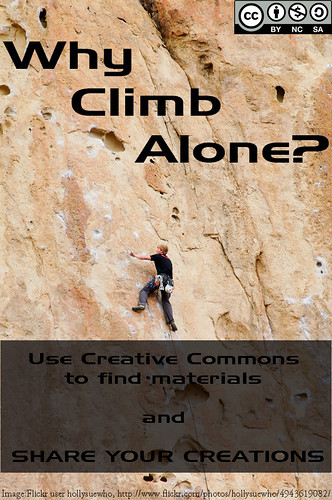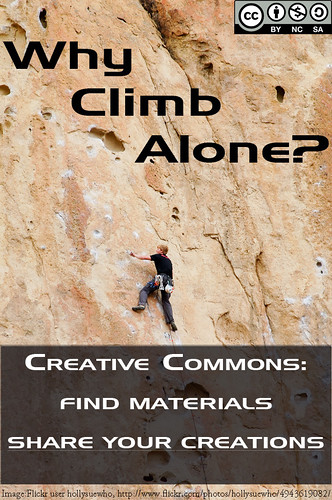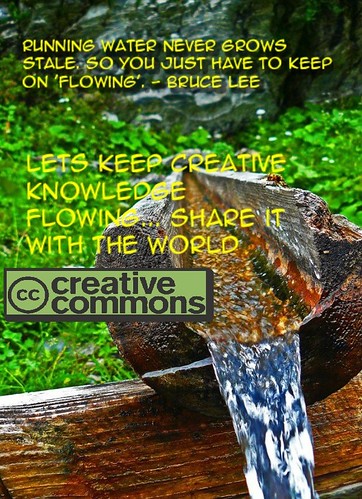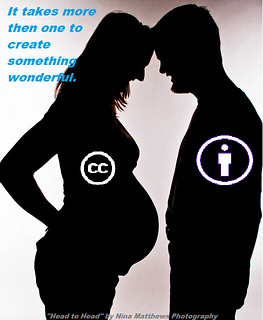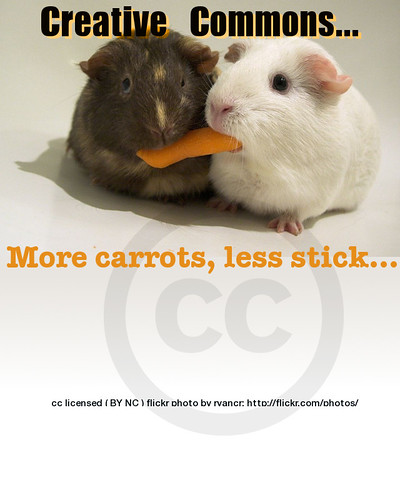Everything is free now
That’s what they say
Everything I ever done
Gonna give it awaySomeone hit the big score
They figured it out
That we’re gonna do it anyway
Even if it doesn’t pay
— Gillian Welch, “Everything Is Free”
Don’t hate me, Gillian Welch.
Not that I’ve ripped off anything from you yet. But at the rate I’m going and since you’re one of my all-time faves — it can’t be long. In my first music remix for my DS106 radio segment, I “borrowed” work from a Karoke orchestra’s version of Summertime, Mamas and Pappas, and Pat Metheny.
I’ve always taken a hard line on copyright and fair use issues with my grad students, believing that they are the last defense for their students to learn to respect the intellectual property of others and their own. One memorable gray area was when Scott used the Beatles’ recording of “Eleanor Rigby” as the soundtrack for his video response (bookcast) to Laurie Halse Anderson’s Winter Girls. He really liked the connection he saw between the anorexic protagonist in Anderson’s novel and Eleanor’s loneliness.
But I thought that he was not using the song in a transformative manner, so advised against. Then he came back with his own rendition of the song that he played on his guitar and recorded. I still think he was wrong to use the piece; the song is not his intellectual property even if he plays it. And I don’t think it’s integral to his piece. Sometimes I worry that we take the easy way out and use popular songs because listeners tend to respond to those faster when we could do a better job if we used our craft to tell our story.
Yet, I’m a huge fan of Pogo of Perth with his unique style of remixing films (most famously, Disney and Pixar films), creating music using syllables, notes, chords, and sound effects only from the movies. His work is transformative, I would argue, and he adds a special value for the public that didn’t exist before.
This is not the first time I’ve grappled with copyright and fair use and make my case in this post for the use of copyrighted materials to be transformative.
So in creating my piece for my cabin’s DS106 radio show, I appropriated up to 30 seconds from the Mamas and the Papas’s “Dancing in the Streets” and Pat Metheny’s “Letters from Home” plus a few seconds from a Karoke version of “Summertime.” How do I feel? Surprisingly, confident that I did nothing wrong and I don’t think it’s rationalization.
The music was integral to the storytelling — not something I chose because it was pretty or I liked it. In each case, the music “chose” me because it was referred to by my those who participated in my inquiry. So is it transformative? You know, I actually think so because I do think I remix music and neuroscience research to share some pretty interesting findings.
Would my piece pass the YouTube test if I uploaded it there? Well, probably not. That’s why I think the work done by Larry Lessig and others in helping us understand that copyright laws need to change to reflect the “art” that we can create today using digital tools. It’s way past due. The only approved uses included in Section 107, US Copyright Law are those of “criticism, comment, news, reporting, teaching, scholarship, or research.” Art that doesn’t fit in those categories is ignored. Tim Wu does a laudable job of helping us frame our questions for this digital era.
One of the questions I’ve framed is inspired by Creative Commons and the encouragement of the Open Educational Resources Foundation (OER Foundation) that creators share their work openly and freely through a BY, attribution-only license. There’s a really interesting discussion of this move to encouraging everyone to choose a “BY” attribution-only tag for their work in Lisa M. Lane’s post, “Why CC-BY Just Isn’t Good Enough.”
In the spirit that “learning should be free for all,” I’ve lobbied for all of the work I develop for online teaching to be free for all — those seeking accreditation pay while those interested in learning for learning’s sake pay nothing. So far, North Carolina State University and the professional associations I’ve developed online courses for have agreed.
But as a free-lancer, I still grapple with how to license the work that I do that is not commissioned. Stories like Alec Couros’s encourage me that there may be good reason to opt for the CC-NC-SA. Ultimately, I’m with Gillian — I’m going to create anyway, even if it doesn’t pay.
I was inspired to create a poster to highlight the Open Educational Resources (OER) and Creative Commons connection. It was the first time I’d attempted to use GIMP to cut and insert objects so I learned a lot. I’ve still much to learn about being precise and smoothing the edges after cutting. I also explored the use of multiple typefaces which has always seemed pretty scary to me. It’s sort of like matching plaids and florals — tricky but effective when done well. In this case, I followed the advice I’d read and used a sans serif title and a serif message that reflected the roundness of the Creative Commons typeface. Would love any feedback on whether or not it works.
I CAN HAS OER THROUGH CREATIVE COMMONS!



